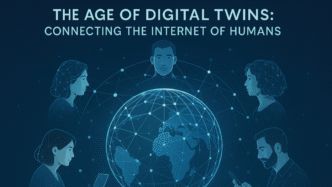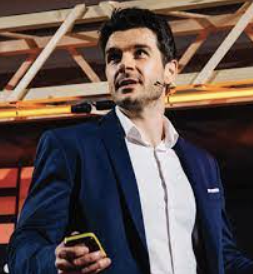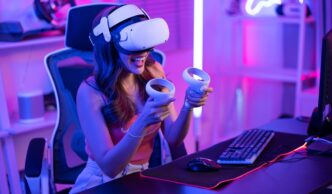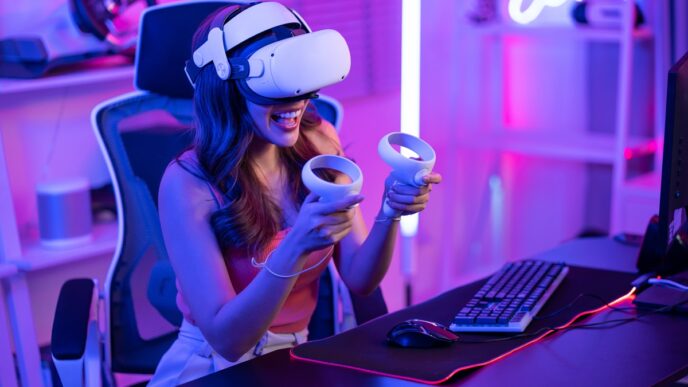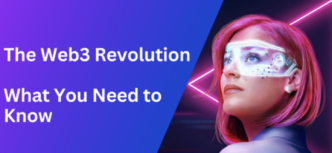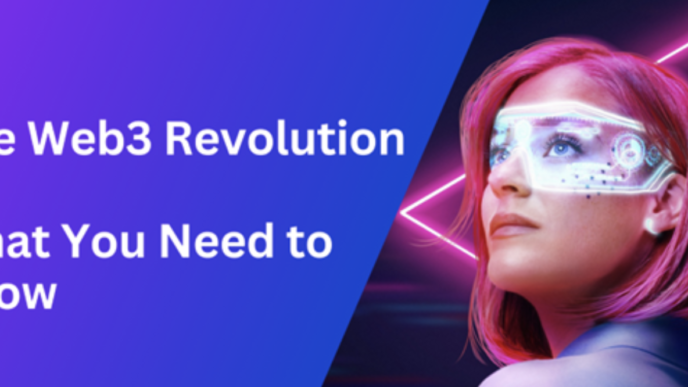Introduction
The fusion of connected devices, AI, and biometric data analytics is ushering in a transformative digital frontier: the Internet of Humans (IoH). This paradigm shift extends beyond the Internet of Things (IoT) and Internet of Bodies (IoB) to create comprehensive digital replicas—human digital twins—that model an individual’s physical, physiological, behavioral, and even emotional states in real time.
Once a domain of industrial automation and smart cities, digital twin technology now reaches into the intimate dimensions of human identity, offering predictive services and deep personalization—but also invoking unprecedented ethical, legal, and societal concerns. No longer confined to factory simulations or high-end health diagnostics, these dynamic, real-time replicas now extend to you: your habits, choices, emotions, even your future decisions.
The emerging trends, as explored in recent report “Digital Twins and the Emerging Internet of Humans” by AB TRUST and summarized in this article show the evolution of IoH and pivotal shift in agency. Let’s deep dive into the technical foundations of human digital twins, the advanced technologies enabling them, and their predictive capacities. Drawing from current research and frontier innovations, we examine what it means to mirror and model a human digitally—and what’s at stake. At the center of this new paradigm lies a powerful, but often unspoken dillema: when a digital model predicts and reponds on your behalf, are you still the making soverign choices?
From IoT and IoB to IoH: A Technological Evolution
The Internet of Things (IoT) laid the groundwork by connecting objects embedded with sensors and software, enabling data collection and automation. From smart thermostats to autonomous vehicles, IoT redefined efficiency. The Internet of Bodies (IoB) evolved this by integrating devices into or onto the human body. From fitness trackers and smartwatches to pacemakers and ingestible sensors, IoB deepened the relationship between humans and machines, making the human body a continuous source of data.
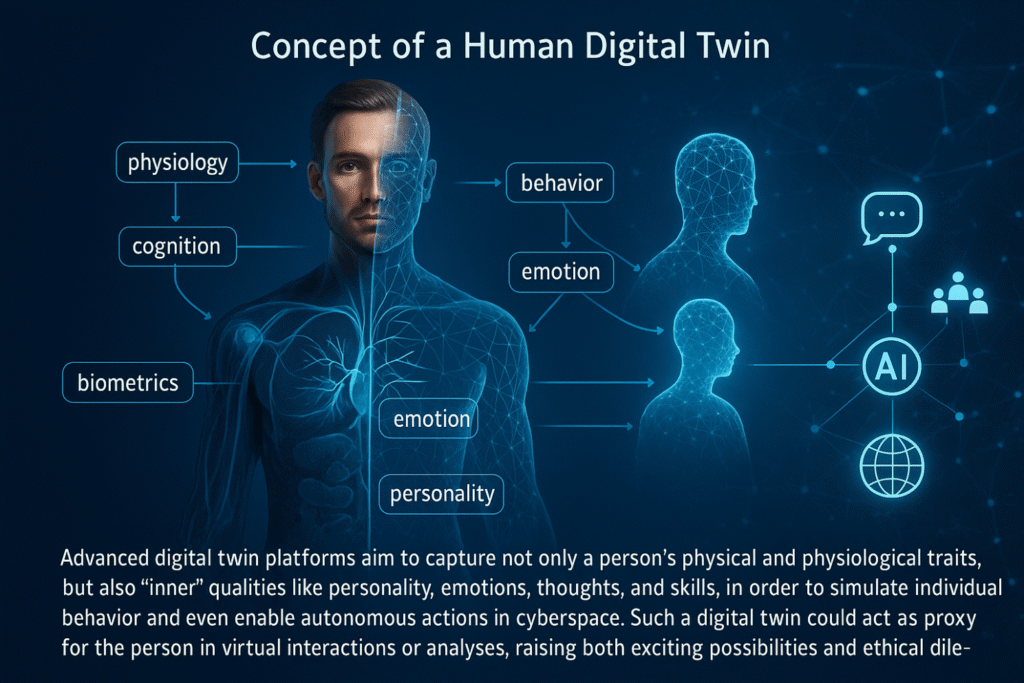
Now comes the Internet of Humans (IoH)—a comprehensive digital ecosystem where individuals themselves are becoming full-fledged nodes within the internet. IoH includes the hardware and networks of IoB but moves into territory where digital systems simulate not only the body, but also emotions, decisions, behaviors, and interactions. In this framework, the human digital twin becomes the central unit—an ever-evolving, AI-enhanced model reflecting its physical counterpart.
Human Digital Twin Architecture: The Building Blocks
Human digital twins (HDTs) consist of three fundamental layers:
- Data Acquisition Layer
Sensors capture data from various sources: physiological (heart rate, temperature, brain activity), environmental (location, temperature), and behavioral (speech, typing speed, social interaction). Devices include wearables, smartphones, neural implants, and smart home interfaces. Data is continuously transmitted via 5G/6G networks and edge computing platforms to ensure minimal latency.
- Modeling and Simulation Layer
The raw data feeds into a modeling engine that integrates multiple modalities—creating a coherent digital representation. Physical and physiological models may include digital organs, movement simulation, or health status predictors. Behavioral models track routines, communication styles, and decision-making patterns. Predictive engines run simulations and generate future-state projections, offering proactive interventions.
- Interface and Feedback Layer
Real-time data flows into user interfaces (AR/VR dashboards, mobile apps), providing actionable insights. Users can visualize their own “digital selves,” receive recommendations, or interact with autonomous agents representing their twin. This two-way feedback loop enables model refinement and maintains alignment between digital and physical realities.
Key Technologies Powering the IoH
Dighital Twins are rapidly migrating from industrial systems into every day life: behavioral modelling in marketing, real-time biometric surveillence, predictive healthcare, and AI-enhanced digital services that respond to micro-emotions before we consciously register them. IoH and HDTs rely on a convergence of emerging technologies:
– Biometric Wearables: From fitness trackers to smart textiles, continuous monitoring of vital signs and movement enables real-time state tracking.
– Neural Interfaces: Non-invasive EEGs, brain implants, and BCIs (e.g., Neuralink) unlock direct insights into cognition and emotional states.
– Behavioral Analytics: Analysis of mobile usage, app interactions, and social media behavior provides rich context for psychological and lifestyle modeling.
– Emotion AI: Algorithms detect and predict emotional states via facial recognition, voice tone, physiological patterns, and textual sentiment.
– Actuators and Autonomous Agents: Smart systems intervene based on twin predictions—adjusting insulin pumps, sending health alerts, or even negotiating virtual tasks on behalf of users.
Predictive Intelligence and Identity Modeling
Consider the economic layer. These twin-based systems are increasingly monetized. Models built on your preferences and behavior are generating commercial value – training recommendation engines, optimizing ad targeting, and refining AI responses. Digital twins aren’t just mirrors—they are predictors powered by machine learning, HDTs anticipate:
- Health risks before symptoms emerge.
- Behavioral deviations that may signal emotional or cognitive decline.
- Scheduling and decision preferences, aiding in personal productivity.
In advanced scenarios, twins may act as proxies, attending virtual meetings, making financial decisions, or maintaining social media presence. These “identity shadows” raise important questions: Who owns the decisions made by your twin? Where is the boundary between assistance and autonomy erosion?
Ethical and Legal Implications
The legal terrain is murky. As the report notes, current privacy laws lag far behind these technological capabilities. Most Digital Twin frameworks operate in regulatory grey zones, relying on broad User agreements or inferred consent. There is no standard mechanism to audit, challenge or reclaim your twin once it has been instantiated. As human identity becomes datafied, the IoH era introduces profound ethical concerns:
– Privacy and Consent: Who controls the data? How is it secured? Can individuals opt out of predictive modeling?
– Algorithmic Bias: If a twin’s model is skewed, predictions may reinforce stereotypes or lead to discriminatory outcomes.
– Mental Sovereignty: Chile’s pioneering move to enshrine neurorights may become a global precedent, ensuring mental integrity is protected like physical health.
– Autonomy and Manipulation: A twin nudging behavior may be helpful—or manipulative. Striking this balance is essential.
Governance and Societal Impact
This slow erosion of personhood has psychological and political implications. If decisions are made for you and you are judged not by your actions, but by what your twin has predicted to do, what space remains for change, reflection, or dissent? Governments, industry consortia, and ethicists must develop robust governance frameworks:
- Digital sovereignty and the right to self-representation must be codified.
- AI transparency—understanding how predictions are made—should be mandatory.
- Legal frameworks must cover AI agency, liability, and rights of digital proxies.
- Cross-sector collaboration is needed to harmonize health, tech, and civil rights policy.
Conclusion: The Human Future in Cyberspace
The Internet of Humans and human digital twins represent a bold reimagining of the human-machine relationship. While these technologies promise enhanced personalization, health outcomes, and productivity, they also challenge foundational notions of identity, autonomy, and agency. Solutions exist, but they require a layered approach. It is time for stronger transparency standards, human-in-the-loop requirements for critical decisions, and the right access/audit to one’s own twin. Equally important and as crucial is cultural reframing: a recognition that predictive models are not neutral observers, but rather representational actors that wield influence whether or not we acknowledge them.
As we stand on the cusp of embedding ourselves digitally into the very infrastructure of society, thoughtful leadership is critical. Industry innovators must prioritize ethical design; policymakers must anticipate future challenges; and citizens must demand transparency and rights in this emerging landscape. None of above suggests that Digital Twins are inherently harmful since they can support wellness, optimize systems, and personalize experiences, but it is obligatory to understand that these benefits come with risks what must be highlighted and mitigated in order to protect uninformed public.
The twin may reflect who we are—but we must decide who we become.
by Anna Bialek CAIO, Industry 5.0 Expert, AI Embedding Strategist with AB TRUST
www.abtrustadvisory.com


